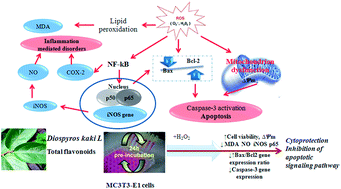Flavonoids from persimmon (Diospyros kaki) leaves (FPL) attenuate H2O2-induced apoptosis in MC3T3-E1 cells via the NF-κB pathway
Abstract
The leaves of persimmon (Diospyros kaki L.) have long been used in Chinese medicine for the treatment of paralysis, frostbite, burns, and to stop bleeding. Flavonoids of persimmon leaves (FPL) are known for their antioxidant activity in murine osteoblast MC3T3-E1 cells, but their mechanisms in osteoblast cells injured by oxidative stress are unknown. In this study, the effects of FPL on oxidative damage were investigated by addressing their potential therapeutic or toxic effects on H2O2-stimulated MC3T3-E1 cells. MC3T3-E1 cells were pretreated with FPL (1.25, 2.5 and 5 μg mL−1) for 24 h and were then exposed to 250 μM H2O2 for an additional 6 h. FPL pre-incubated with MC3T3-E1 cells did not present any cytotoxicity, instead they increased cell viability and ΔΨm in a dose-dependent manner when challenged with H2O2. Treatment with this pro-incubated FPL also significantly suppressed the production of MDA and NO and the activity of iNOS. The mRNA expression of iNOS, COX-2, Bax, Bcl-2, and caspase-3 and the protein expression of NF-κB/p65 showed that FPL significantly inhibited apoptosis in H2O2-stimulated MC3T3-E1 cells. These results suggest that the molecular mechanism of FPL in anti-apoptosis was associated with the suppression of the translocation of NF-κB/p65 into the nucleus. The protective effect of FPL could provide a promising approach for the treatment of osteoporosis.


 Please wait while we load your content...
Please wait while we load your content...